Malaysian art collective Projek Rabak survey participations at Documenta fifteen, Kassel and at Pera + Flora + Fauna. The Story of Indigenousness and the Ownership of History, as an official Collateral Event at the 59th International Art Exhibition – La Biennale di Venezia. Their exhibits invite visitors in the Collateral Event of La Biennale Art di Venezia to explore, participate and immerse themselves in the Semai culture by interacting with the exhibit. Through the interaction, the world can embody Semai values and holistic approach towards life.
Their interactive piece symbolizes our reimagined narrative whereby Semai culture is at the global forefront, as well as the Semai spirit of co-existence and genuine closeness to bonding with all who cross their path, in this case, the world. Reimagining indigenous people as being central in the environment and the world, the ‘fabric’ of the traditional attire represents Semai’s fabric of life. Through interactive art, a meaningful connection to coexist and its sentimental value can be instilled between the Semai people and global citizens.
The 59th International Art Exhibition runs from 23 April to 27 November 2022
Documenta Fifteen, from June 18 to 25 September 2022
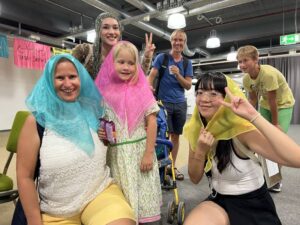
Tudung Bawal (2022) is an installation piece by Dhan Illiani Yusof for Projek Rabak ‘s show at documenta fifteen.
Since the beginning of Projek Rabak in 2011, community has always been a constant. Though the landscape of art is ever-changing, the communal ethos stays forever collective. The art process is like one big kenduri, a communal feast with people from all walks of life conjoined by the joy of creating, making noise, experimenting and playing together.
Apart from being an artist collective, they celebrate the spirit of camaraderie and friendship. In this exhibition and art project, they want to showcase outsider’s perspective on the creative process and craft, whilst highlighting the lives, heritage, and culture of our Semai (an indigenous tribe in Peninsular Malaysia) friends as collaborators and fellow artists/exhibitors. Deeply inspired by the absurdity, playfulness and openness of pop art; the collaborative nature of Southeast Asian practices like gotong royong, which is better known as ‘joint bearing of burdens’ or ‘mutual assistance’, we want to combine our creative philosophy and aesthetics while celebrating Semai culture.
Projek Rabak was founded by Mohd Jayzuan with five other Ipoh friends in 2011.
Over the next few years after the formation, Projek Rabak managed to initiate multiple projects: the book publishing house, Rabak-Lit (2012), their first art space; Khizanat (2013), Rabak Studio (2013), Projek Rabak Gallery (2015), Rumah Khizanat (2015) and the week-long arts festival ‘Ipoh Kreative’ (2015-2017).
In term outside of Malaysia, Projek Rabak opened Kedutaan Ipoh (2019), a networking space in Gudskul, Jakarta Selatan, Indonesia and Kedutaan Ipoh (2020) in Hiroshima, Japan.
Projek Rabak focuses on nurturing new young artists across a wide spectrum of the arts, especially in contemporary art, literature, performance art, film, music, video and so on.
Camilla Boemio: Can you introduce yourself, and the other artists part of Projek Rabak?
Projek Rabak is a very fluid collective with many members, so there are many artists and friends in Projek Rabak. It would be a long list if I were to introduce others. As for this interview, Mohd Jayzuan and Ranerrim will be answering all the questions.
I’m a visual artist and my works are experimental and conceptual in nature, playing with themes of philosophical concepts laced with socio-political commentary. Inspired by mundane yet absurd day-to-day life, is fascinated by how micro human experiences like the flowing of time, memories and humour can coalesce with macro social systems.
Generally, to introduce Projek Rabak, we are a multidisciplinary artist group, we practise lots of art forms ranging from music, film, literature, performance art, video, installation and many other things. We also organize and curate festivals, exhibitions, markets and kenduri.
We published books, music albums, documentaries, t-shirts and merchandise as well.
CB: How do you describe your own art practice?
Celebrating youth culture, collectivism, contemporary arts, literature, visual, installation, performance art, experimental initiative, filmmaking and many other forms of arts—Projek Rabak has been organizing, collaborating and been involved in events and festivals, all of which were materialized with the acts of love and courtesy of friends. Our artistic process became a practice of togetherness in managing, organizing and propagating the collectivity that could be eulogized as the art in the making of Projek Rabak. Devoted to this, Projek Rabak embraces not merely artists but as well as intellectuals, cultural workers, social activists, rural community organizers and most of all, common everyday people.
Our ecosystem is very open and not just for artists.
CB: How does your research draw inspiration? What is your greatest source of inspiration?
Our greatest source of inspiration comes from the art of lepak and the celebration of life and friendship.
From the beginning of its existence, Projek Rabak took this concept in its work ethos,way of life and philosophy. ‘Lepak’ is similar to the concept of ‘nongkrong’ in Indonesia and in English, ‘to hangout’. Through hangouts, ideas will be sparked–debates, discussions, schemes or maybe just empty chat, but the most central thing to this practice is friendship.
CB: Which topics are central in your work?
One of Projek Rabak’s philosophies is “Life first, art later.” Community has always been part of our art practice because we believe that art can (and should) be made through the celebration of life, friendship and the never-ending process of observing and learning about the perspectives of everyday people. Art and life is a never ending exploration for Projek Rabak, even though it is a decade old, that’s how we keep ourselves joyful in our creative process.
CB: Can you introduce us to Seni-Kenduri / The Art of Feast realized at documenta fifteen, ruruHaus?
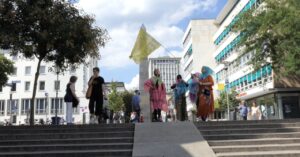
The opening of Projek Rabak’s ‘Seni-Kenduri \ The Art of Feast’ for documenta fifteen, Kassel, Germany. Walking as a gesture of solidarity with ruangrupa, Taring Padi and documenta fifteen, reading Rabak’s manifesto for the first time.
Our show at documenta fifteen, Seni-Kenduri\ The Art of Feast is very demonstrative of Projek Rabak’s art practice.
‘Kenduri’ is a Malay word which means feast. Kenduri as a concept has the elements of gotong-royong (mutual cooperation), helping, gathering, making friends and socializing with people from various backgrounds. This concept has long existed in Southeast Asia, working together to achieve one goal–which is usually for the purpose of celebration. It is a common festival in the villages where people help each other to prepare the ceremony or celebration.
During our time in documenta fifteen, we threw a kenduri as our main event for two days as part of our exhibition. Our main intention for this program is to bring the art of lepak in our art sphere. Lepak is one of the basic essences of ‘kenduri’.
In the ‘kenduri’, we provided and served the famous teh tarik (pulled milk tea) and Malaysian snacks for the guests who join the ‘kenduri’ with us. Our works for the exhibition consisted of two part performances and installation pieces, two collectible prints in conjunction with our kenduri and documenta fifteen, wood-cut drawings which depict Projek Rabak’s manifesto and a video art. The details of the works are below:
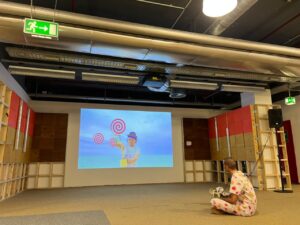
Tanpa Teh Tarik, Kita Yilekkk \ Without Teh Tarik, We’re Nothing (2022) is a video art piece by Mohd Jayzuan for Projek Rabak’s show at documenta fifteen.
- i) Video Art: ‘Tanpa Teh Tarik, Kita Yilekkk \ Without Teh Tarik, We’re Nothing (2022)’
The video art shows how to make a proper glass of teh tarik, a Malaysian pulled tea, iconically known as a social drink among all Malaysians regardless of race, class and gender. This video art pays homage to this beverage.
It represents the symbol of Malaysian culture, without boundaries and class either for the elites and ordinary people; from Royalty to bus conductor to lawyer to various classes of people–most Malaysians are attached to teh tarik. It’s beyond race, class and religion.
The video also is a salutation to all teh tarik makers around the world, a symbolic act against racism, prejudice and class.
- ii) Detail Drawings: ‘ Panduan Projek Rabak \ Projek Rabak Handbook (2022)’
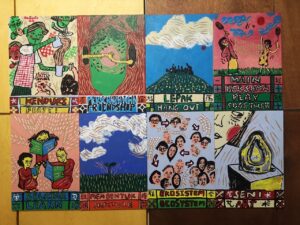
An artwork by Ranerrim, titled Panduan Projek Rabak \ Projek Rabak Handbook (2022), an illustration of Projek Rabak’s visual manifesto of the eight philosophies of the collective
The detailed drawings depict and elaborate our practice and ethos as a collective. In other words, it is Projek Rabak’s visual manifesto. It’s a continuation from the bigger theme ‘Seni-Kenduri \ The Art of Feast’ (2022)’ so that people can understand and get more insights into our art practice and the art of ‘Kenduri’.
- Kenduri \ Feast
- Perkawanan \ Friendship
- Lepak \ Hangout
- Main Bersama \ Play Together
- Belajar \ Learn
- Membentuk \ Nurture
- Ekosistem \ Ecosystem
- Seni \ Arts
Lauk Pauk Paus \ Dish Whale (2022)’ is a performance art piece created by Dhan Illiani Yusof for Projek Rabak’s documenta fifteen show. 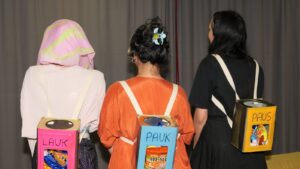
Lauk Pauk Paus \ Dish Whale (2022)’ is a performance art piece created by Dhan Illiani Yusof for Projek Rabak’s documenta fifteen show.
iii) Interactive Installation-Performance: ‘Lauk Pauk Paus \ Dish Whale (2022)’
In a ‘kenduri’, the dishes and condiments are served in bulk and people help themselves to the array of servings. In Lauk Pauk Paus, attendees can act as a Whale of ‘Lauk’, harboring resources, the people attending the exhibit are able to wear a tin of biscuits as a backpack becoming part installation–performance.
Whales act as ecosystem engineers, they recycle nutrients and enhance primary productivity in areas where they feed. They do this by feeding at depth and releasing fecal plumes near the surface — which supports plankton growth — a remarkable process described as a ‘whale pump’. Whales also move nutrients thousands of miles from productive feeding areas at high latitudes to calving areas at lower latitudes.
This piece presents how resources circulate, simultaneously in the form of food sharing (lumbung), conversation and knowledge in people (lepak). People are able to go around enjoying the biscuits from the tins worn by people in the vicinity and strike a conversation while they mingle.
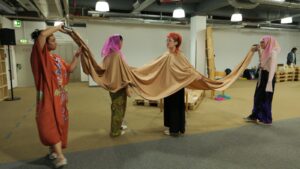
One of our Projek Rabak’s documenta fifteen works, Taaaaaaaarrrrik Free Flow! (2022) by Dhan Illiani Yusof.
This part performance and interactive installation piece is inspired by Teh Tarik, flash floods in Malaysia and also how many Kenduris continue go on despite the tumultuous Malaysian weather.
- iv) Installation: ‘Taaaaaaaarrrrik Free Flow! (2022)’
Taaaaaaaarrrrik Free Flow! is a fabric set up around the exhibit to capture the current reality of the climate crisis happening in Malaysia, very notably the frequent flash floods that have become a common occurrence disrupting even central city areas, and in other parts a yearly occurrence of displacement in the increasing climate crisis. At the same time, it is inspired by teh tarik and how kenduris continue to go on despite the tumultuous Malaysian weather.
Typically, ‘Kenduri’ are mobile and adaptable.It can be held on lush fields in nature or concrete roads in an urban jungle or just public hall. Basically, anywhere because ‘Kenduri’ is made by people and not the environment or venue.
Malaysia is a country of torrential rain and thunderstorms, which makes it common for ‘Kenduri’ to be experienced in the mercy of nature. Sometimes, where ‘Kenduri’s are held will be filled with mud in the aftermath of a storm.Despite such adversities, the practice of ‘Kenduri’ still continues strong through muddy landscapes – lands, puddles and unpredictable weather.
With the concept of the ‘Kenduri’ culture in Malaysia in the current twist of real life messy, muddy, windy, frequently flooding times in Malaysia.
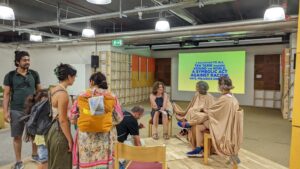
- v) Collectible Item: ‘Jemputan Khas \ Open House Invitation (2022)’
Before the kenduri, we invited people by physically handing out invitations specially printed in conjunction with documenta fifteen. This is a common practice for kenduris in Malaysia as well.
CB: You wrote that the most central thing to your practice is friendship. Tell us more on.
We truly believe in cultivating talent and potential in the spirit and art of friendship. By embracing different perspectives, ideas and personalities from all walks of life through friendship, we expand our horizons as human beings, as artists. This approach is important because it helps to give us depth and richness in the way we think, experience life and approach our art because each new conversation adds a different layer of dimension in the way we understand this world.
Our relationships are shaped through mutually enriching reciprocity. It is not just a one way street. From a body of people, Projek Rabak sustains by becoming not just an artist collective but a state of mind.
CB: Treat art as therapy, something therapeutic always makes sense in society. Humans connect with emotions, anything that gives them some kind of feelings will be embraced.
CB: Can you introduce your contribution installation at Pera + Flora + Fauna?
In Pera + Flora + Fauna, we exhibited the following:
- i) Drawings and works by the Semai community
- ii) Pictures photographed by Yahya Torek
iii) Minggu Fesyen Semai \ Semai Fashion Week (2022)
- iv) Dari Kampung Ras ke Venice \ From Kampung Ras to Venice (2022)
- v) 12 Process Drawings depicting various cultural practices of the Semai community
The purpose of the drawings by the Semai community is to visually document their culture, everyday life and history. Both the kids and the adult Semai artists that joined in the session all helped us understand their current realities and way of life. Some Projek Rabak members also joined in the drawing and colouring while asking questions about the drawn elements. The session was a way for us to share art as a visual language for communication and understanding, but essentially it was an open space for anyone in the village to sit together and join in on the fun.
Like most of our projects, our collaboration with the Semai community began with a friendship. Yahya Torek (one of the indigenous Semai people) is an old friend of Projek Rabak. We thought it most appropriate to work with him on this project, even though he is not a master at photography or videography. We approached him to work with us as videographer and photographer because we want to see life through the eyes of an indigenous Semai person, from his own narrative, It was imperative for us to have Semai people behind the camera, rather than in front of the camera, as we didn’t want to turn them into objects of the ‘gaze’ or subjects of inquiry. We wanted them to be artists and work with us to tell the world their story, while we contribute our aesthetic vision and artistic ideas. It means a lot to Yahya and us that our collaborative documentary is the first documentary about the Semai community to be created by a Semai person.
CB: Do you think that every form of art is political?
We believe that art is a reflection of life and life is always political. From food to cultural practices – history and politics play a role in the way we understand such subjects. Even if a piece of art is not expressly political or demonstrative, as long as there are elements of life and about life, it will always be political.





















































